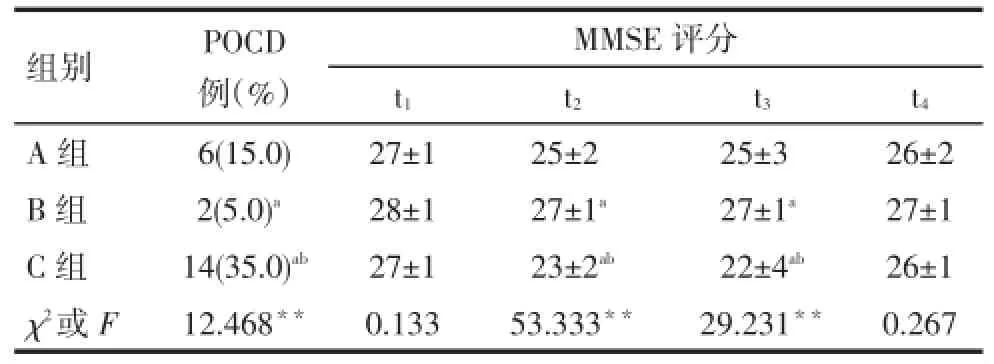右美托咪定对老年人髋部手术后认知功能障碍的影响
2015-08-24张云飞高伟忠马世颖刘金碧
张云飞,高伟忠,马世颖,刘金碧
药物临床观察
右美托咪定对老年人髋部手术后认知功能障碍的影响
张云飞,高伟忠,马世颖,刘金碧
目的 观察硬膜外麻醉复合不同剂量右美托咪定对老年人髋部手术后循环和认知功能障碍(POCD)的影响。方法 选择2013年6月—2014年9月,65岁以上髋部手术患者120例,行硬膜外麻醉联合右美托咪定静脉泵注,按右美托咪定的泵注量不同,分为A组0.2 μg·h-1·kg-1,B组0.4 μg·h-1·kg-1和C组0.6 μg·h-1·kg-1,每组40例。观察并记录3组患者入室时(T0)、用药后10 min(T1)、用药后20 min(T2)、停药即刻(T3)、停药后10 min(T4)以及手术完毕时(T5)的心率(HR)、平均动脉压(MAP)、血氧饱和度(SpO2)。应用简易智力状态量表(MMSE)测试3组患者术前24 h(t1)、术后12 h(t2)、术后24 h(t3)及术后72 h(t4)认知功能。结果 3组患者在T0时MAP、HR及SpO2比较差异无统计学意义;C组T2、T3时HR和MAP均较A组、B组明显下降(均P<0.05)。3组术前MMSE评分差异无统计学意义,B组t2、t3时的MMSE评分均明显高于A组和C组(P<0.05);B组POCD发生率明显低于A组和C组(P<0.05)。结论 硬膜外麻醉复合右美托咪定以0.4 μg·h-1·kg-1静脉泵注对老年患者的循环干扰小,可减少老年患者围手术期认知功能障碍的发生。
麻醉,硬膜外;认知障碍;手术后期间;老年人;右美托咪定
老年患者术后认知功能障碍(POCD)十分常见,严重影响生活质量。研究发现右美托咪定(dexmedetomidine,DEX)具有中枢抗交感作用,能维持心血管功能稳定,抑制应激反应和炎症反应等,降低老年患者POCD的发病率,但对右美托咪定的适宜剂量缺乏大规模的临床研究[1],且右美托咪定专家指南(2013版)规定的右美托咪定使用剂量范围较大[2],临床工作中发现不同剂量右美托咪定所产生的效果差别较大,本研究通过观察硬膜外麻醉复合不同剂量右美托咪定对老年人髋部手术POCD的影响,为临床使用提供参考。
1 资料与方法
1.1 一般资料 选择2013年6月—2014年9月本院硬膜外麻醉行髋部手术老年患者120例。ASA分级Ⅰ~Ⅱ级,年龄≥65岁。排除标准:青光眼、痴呆或精神分裂症;有严重高血压病史、缺血性心脏病史、心脏传导阻滞病史;服用抗抑郁药物或β受体阻滞药物者;拒绝参加本研究者。采用随机数字表法随机均分为3组,A组、B组和C组的剂量分别为0.2、0.4、0.6 μg·h-1·kg-1,静脉泵注。其中股骨头坏死38例,粗隆间骨折31例,股骨颈骨折46例,髋臼骨折5例。所有患者麻醉均由同一工作组完成。本研究经医院伦理委员会批准,所有入选患者均被告知研究内容,并签署知情同意书。
1.2 麻醉方法 所有患者麻醉前常规监测血压(BP)、脉搏、呼吸及脉搏血氧饱和度,开放静脉通路,滴注乳酸林格注射液,予盐酸右美托咪定静脉持续泵注。侧卧位选择L2~3间隙行硬膜外穿刺,头侧置管3 cm,予2%利多卡因试验量3 mL,待麻醉平面出现,排除蛛网膜下腔麻醉后,予0.894%罗哌卡因6 mL硬膜外腔注入,留置硬膜外导管备术中追加局麻药物和术后硬膜外自控镇痛(PCEA),术中控制麻醉平面在T10以下,所有患者面罩吸氧(流量2 L/min),在清点器械准备缝合创面时停泵注盐酸右美托咪定。若患者术中BP降低超过基础值的20%,给予麻黄碱10 mg静脉注射;若心率(HR)<55次/min,给予阿托品0.5 mg静脉注射。
1.3 监测指标 (1)一般资料。性别、年龄、体质量、ASA分级、术中失血量,手术时间、麻醉时间。(2)不同时点循环指标及血氧饱和度(SpO2)指标。患者入室时(T0)、用药后10 min (T1)、用药后20 min(T2)、停药即刻(T3)、停药后10 min(T4)以及手术完毕时(T5)的HR、平均动脉压(MAP)、SpO2。(3)认知功能评定。应用简易智力状态检查(MMSE)[3]测试方法分别评定3组患者术前24 h(t1)、术后12 h(t2)、术后24 h(t3)及术后72 h(t4)的认知功能。总分为30分,≤23分为认知功能缺陷,下降2分以上为认知功能下降。所有患者术后予48 h PCEA,配方为甲磺酸罗哌卡因注射液400 mg加生理盐水至200 mL,速度为4 mL/h,追加量(自控镇痛剂量)为:2 mL,锁定时间15 min,维持VAS评分≤4分。
1.4 统计学方法 采用SPSS 18.0统计软件进行分析。计量数据以±s表示,组间比较采用单因素方差分析,组间多重比较用SNK法,计数资料用例或例(%)表示,组间比较采用卡方检验,P<0.05为差异有统计学意义。
2 结果
2.1 一般资料及术中情况比较 3组患者一般资料各指标以及手术时间、麻醉时间、失血量比较差异均无统计学意义,见表1。
Tab.1 Comparison of the parameters of general data and intraoperative situation in patients among three groups表1 3组患者一般资料及术中情况各指标的比较(n=40,±s)

Tab.1 Comparison of the parameters of general data and intraoperative situation in patients among three groups表1 3组患者一般资料及术中情况各指标的比较(n=40,±s)
均P>0.05
组别 男/女 年龄 体质量ASA分级(岁) (kg) (Ⅰ/Ⅱ)A组22/1869±759±1128/12 B组23/1772±663±1126/14 C组21/1971±662±1226/14 χ2或F0.2022.3141.3470.300组别 手术时间(min) 麻醉时间(min)失血量(mL)A组136±51144±40419±155 B组132±38146±38428±200 C组142±39150±38368±158 χ2或F0.5460.2501.412
2.2 不同时点循环指标及SpO2比较 3组患者在T0时HR、MAP比较差异均无统计学意义,T1时HR 和MAP均较基础值降低。与A组、B组相比,C组患者T2、T3时HR及MAP明显下降,差异有统计学意义(P<0.05)。3组患者SpO2差异无统计学意义,见表2。
2.3 3组患者术中血管活性药物用量比较 C组术中麻黄碱及阿托品用量比例高于A组和B组(P<0.05),见表3。
2.4 3组患者POCD发生率及不同时点MMSE评分比较 B组术后POCD发生率低于A组、C组(P<0.05)。3组患者术前(t1)MMSE评分差异无统计学意义。B组患者t2、t3的MMSE评分均明显高于A组和C组(P<0.05),见表4。
3 讨论
POCD是指术前无精神异常的患者麻醉手术后,出现暂时性可逆的记忆力和定向力等认知功能障碍,同时伴有人格和社交能力的改变,少数患者发展为永久性损害。POCD的发生与创伤应激、炎症反应及中枢胆碱能系统功能降低等因素有关[4]。同时,年龄是发生POCD的高危因素,老年人大脑神经元数量减少,与认知功能相关的受体,尤其是胆碱能受体的减少及对麻醉药的敏感性增加都是发生POCD的重要原因。循证医学和动物实验表明,神经元形态和生物学重构是通过激活炎性因子介导的炎症反应造成中枢神经系统炎性反应,在大脑最易受到影响的老年期,引起认知功能受损[5-7]。动物实验也证实,在手术或外周炎性刺激时,老年大鼠较成年大鼠更容易发生POCD[8]。MMSE量表具有简便易行、不受情绪影响,敏感性和特异性均较高等特点,故国内外普遍采用MMSE评分法评判患者是否发生POCD[9]。
Tab.2 Comparison of parameters of circulation indicator and oxyhemoglobin saturation in different time points among three groups表2 3组不同时点循环指标及SpO2比较 (n=40,±s)

Tab.2 Comparison of parameters of circulation indicator and oxyhemoglobin saturation in different time points among three groups表2 3组不同时点循环指标及SpO2比较 (n=40,±s)
*P<0.05,**P<0.01;a与A组比较,b与B组比较,P<0.05;表3、4同;1 mmHg=0.133 kPa
指标组别T0T1T2T3T4T5HR(次/min)A组67±664±463±561±464±566±5 B组66±565±362±460±565±665±3 C组69±863±555±6ab51±5ab62±667±6 F 2.2402.40029.610**55.152**2.8871.714 MAP(mmHg)A组86±582±980±878±683±584±6 B组84±581±779±679±682±582±7 C组84±679±773±6ab71±7ab81±682±8 F 1.8601.56412.647**18.843**1.3951.074 SpO2A组0.95±0.040.99±0.010.99±0.020.99±0.010.99±0.010.99±0.01 B组0.96±0.020.99±0.010.99±0.010.99±0.010.99±0.010.99±0.01 C组0.95±0.030.99±0.010.99±0.010.99±0.010.99±0.010.99±0.01 F 0.021<0.001<0.001<0.001<0.001<0.001

Tab.3 Comparison of different dosage in patients during perioperative period表3 3组患者围术期辅助用药量比较[n=40,例(%)]

Tab.4 Comparison of the incidence of POCD and MMSE score in patients among different groups表4 3组患者POCD发生率及MMSE评分比较(n=40)
右美托咪定属咪唑类衍生物,是一种新型高选择性α2受体激动剂,具有良好的镇静、镇痛及可唤醒的特点,又由于呼吸抑制轻和血流动力学稳定等特点,而广泛应用于临床麻醉中[2]。已有研究表明其可以通过减少炎症因子如白细胞介素(IL)-1β和IL-6等的表达,来减轻炎症反应,减少POCD的发生[10]。
髋部手术刺激强,应激使免疫系统产生大量炎性介质,通过炎性反应产生大量炎性因子,进而干扰神经活动,引起中枢神经系统退行性变,造成认知功能障碍。本临床观察中B组POCD发生率较A组、C组低(P<0.05),可能与A组右美托咪定剂量较低,不足以干预炎性因子的产生有关。老年患者心肺储备功能减低,血管顺应性差,对循环的调节能力有限,C组使用较大剂量右美托咪定使循环抑制造成血压波动,导致脑组织供血不足,造成缺血缺氧脑损伤,同时C组中使用抗胆碱药阿托品的量较A组和B组多(P<0.05),抗胆碱药可明显增加POCD的发生[11]。
综上所述,硬膜外麻醉复合0.4 μg·h-1·kg-1右美托咪定在老年人髋部手术中血流动力学平稳,术后POCD发生率低,值得临床推广。
[1]Wan L,Jin LM,Cui CL,et al.The current studies on the effects of dexmedetomidine on postoperative cognitive dysfunction in the elerly[J].Chinese Journal of Gerontology,2013,12(33):6339-6345.[万利,金立民,崔常雷,等.右美托咪定在老年人术后认知障碍应用的研究进展[J].中国老年病学杂志,2013,12(33):6339-6345].doi:10.3969/j.issn.1005-9202.2013.24.138.
[2]Chinase Society of Anesthesiology.The guidelines of dexmedetomidine in clinical practice(2013)[J].Chinese Journal of Anesthesiolo-gy,2013,10(33):1165-1169.[中华医学会麻醉学分会.右美托咪定临床应用指导意见(2013)[J].中华麻醉学杂志,2013,10(33): 1165-1169].
[3]Ji MH,Shen JC,Gao R,et al.Early postoperative cognitive dysfunction is associated with higher cortisol levels in aged patients following hip fracture surgery[J].J Anesth,2013,116(5):533-540.doi:10.1007/s00540-013-1633-5.
[4]van Harten AE,Scheeren TW,Absalom AR.A review of postoperative cognitive dysfunction and neuroinflammation associated with cardiac surgery and anaesthesia[J].Anaesthesia,2012,67(3):280-293.doi:10.1111/j.1365-2044.2011.07008.x.
[5]Vaeas S,Degos V,Tracey KJ,et al.High-mobility group box 1 protein initiates postoperative cognitive decline by engaging bone marrowderived macrophages[J].Anesthesiology,2014,120(5):1160-1167.
[6]Li AM,Shi YS,Gao RP,et al.The neuroprotective effect of dexmedetomidine during periopererative period in patients with meningioma[J].Journal of Clinical Anesthesiology,2013,29(7):665-673.[李爱梅,石翊飒,高瑞萍,等.不同剂量DEX托咪定对脑膜瘤切除术患者术后认知功能的影响[J].临床麻醉学杂志,2013,29(7):665-673].
[7]Yu T,Qiu HB.Dexmedetomidine in the prevention and treatment of delirium in critically ill patients[J].International Journal of Anesthesiology and Resuscitation,2011,32(3):341-343.[于涛,邱海波.右美托咪啶在重症患者谵妄的预防和治疗作用研究进展[J].国际麻醉学与复苏杂志,2011,32(3):341-343].doi:10.3760/cma.j.issn.1673-4378.2011.06.022.
[8]Sezer A,Memis D,Usta U,et al.The effect of dexmedetomidine on liver histopathology in a rat sepsis model:an experimental pilot study [J].Ulus Travma Acil Cerrahi Derg,2010,16(2):108.
[9]Wu XM,Xu X,Wang JK,et al.Efficacy and safety of intravenous dexmedetomidine as an adjunct to general anesthesia[J].Chinese Journal of Anesthesiology,2007,27(9):773-776.[吴新民,许幸,王俊科,等.静脉注射右美托咪啶辅助全身麻醉的有效性和安全性[J].中华麻醉学杂志,2007,27(9):773-776].
[10]Hudetz JA,Gandhi SD,Iqbal Z,et al.Elevated postoperative inflammatorybiomarkers are associated with short-and medium-term cognitive dysfunclion after coronary artery surgery[J].Anesthesiology,2011,25(1):116.doi:10.1007/s00540-010-1042-y.
[11]Gerlach AT,Dasta JF,Steinberg S,et al.A new dosing protocol reduces dexmedetomidine-associated hypotension incritically ill surgical patients[J].JCritCare,2009,24(4):568-574.doi:10.1016/j.jcrc.2009.05.015.
(2014-10-03收稿 2015-02-02修回)
(本文编辑 李国琪)
Dexmedetomidine on cognitive function of elderly patients who underwent hip orthopedic surgery
ZHANG Yunfei,GAO Weizhong,MA Shiying,LIU Jinbi
Department of Anesthesiology,the First People’s Hospital of Zunyi,Guizhou 563000,China
Objective To observe the effect of a variety dosage of dexmedetomidine on circulatory and cognitive functions in elderly patients who underwent hip orthopedic surgery.Methods A total of 120 patients who underwent hip orthopedic surgery,with age over 65 years old were recruited from 06/2013 to 09/2014 and were administered intravenously dexmedetomidine after epidural anesthesia.Based on the dosage of dexmedetomidine,patients were randomly divided into 3 groups with 40 cases in each group:Group A were given 0.2 μg·h-1·kg-1dexmedetomidine;Group B were given dexmedetomidine 0.4 μg·h-1·kg-1,and group C were given 0.6 μg·h-1·kg-1.The heart rate(HR),mean arterial pressure(MAP),and pulse oxygen saturation(SpO2)were recorded at 6 time points,including the time entering operating room(T0),10 min(T1),20 min(T2)after drug administration,the time of drug withdrawal(T3),10 min after drug withdrawal(T4)and the terminal time of surgery(T5)respectively.Cognitive function was evaluated by mini-mental state examination(MMSE)at the time points of 24 hours before surgery(t1),12 hours(t2),24 hours(t3),and 72 hours(t4)after surgery.Results All 3 groups of patients show no significant differenceof MAP,HR and SpO2at T0(P>0.05).A significant decrease in MAP and HR were observed in Group C at T2and T3time points compared to those in Group A or Group B(P<0.05).There was no significant difference in MMSE at time point T1among all three groups(P>0.05).However,compared to that in group A or group C,MMSE increased significantly at time point T2,T3in group B(P<0.05).In addition,compared to group A or group C,the patients in group B exhibited lower incidence of postoperative cognitive function disorder(P<0.05).Conclusion Continuous intravenous infusion of Dexmedetomidine can be used in elderly patient who underwent hip orthopedic surgery at the dose of 0.4 μg·h-1·kg-1safely with little interference to circulatory and cognitive function in perioperative period.
anesthesia,epidural;cognition disorder;postoperative period;aged;Dexmedetomidine
R614
A DOI:10.11958/j.issn.0253-9896.2015.06.023
基金名称:遵义市科学技术局联合科技研发资金项目[遵市科合社字(2014)14号]
遵义市第一人民医院麻醉科(邮编563000)
张云飞(1973),男,学士学位,副主任医师,主要从事困难气道方面研究
